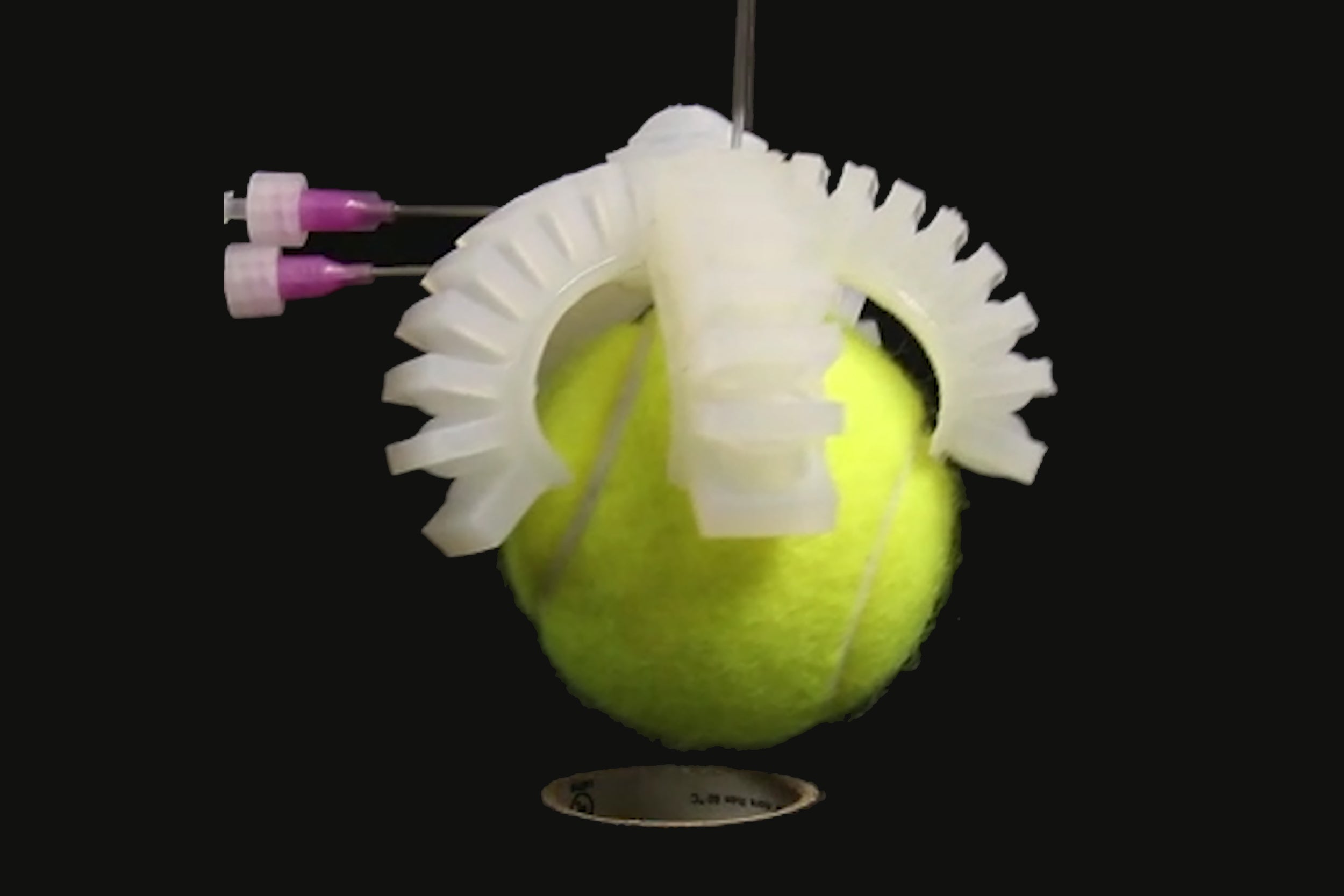2018/12/6 アメリカ合衆国ハーバード大学

・ ハーバード大学が、ソフトロボットで使用されている従来の硬い空気弁を代替するソフトな空気弁を開発。
・ ソフトな同空気弁の構造では、振動運動の生成やソフトなロジック回路の構築にも利用が可能で、全体的にソフトなロボットの開発につながる可能性も期待できる。
・ 近年、ソフトでフレキシブルなエラストマーを使用した、物体の把持や歩行、跳躍が可能なソフトロボットの開発が進んでいるが、ロボットの挙動を作る膨張と収縮は市販の硬い空気弁で制御されている。
・ 同ソフト空気弁は、上下のチャンバーをシリコン膜で分離したシリンダー型で、下部チャンバーにかかる空気圧によりシリコン膜が持ち上がり、圧力を解放すると元の状態に戻る。このようなシリコン膜の動きは、チャンバー内部に同膜を挟んで上下に配置されるチューブの動きによるもの。空気圧の有無により上下部チューブがよじれた状態と真直ぐに伸びた状態を繰り返すことで、効果的な弁のオン・オフ機能を提供する。
・ 同ソフト空気弁による物体把持の実証では、複数の指を持つグリッパーに同空気弁を組込み、空気弁下部チャンバーの空気圧を逃がす微小なベントを追加した。同グリッパーがテニスボールに向かって下方移動すると、ベントが閉じて下部チャンバーが加圧され、空気弁が作動してグリッパーが自律的に働く。
・ また、一定の空気圧の供給による空気弁の振動運動を生成する「フィードバック」システムも構築。同システムでは、上部チャンバーから下部チャンバーに空気圧を流し、シリコン膜が持ち上がるとその流れが断たれて下部チャンバーが空気圧を解放し、膜が元の状態に戻るというサイクルを繰り返す。これを利用してシャクトリムシのような単純な動きをするロボットを作製。一定の圧力を供給するだけで自律的に歩行運動を生成する。
・ 今後は、同空気弁を様々な用途や形態に対応させるための最適化を進める。また、同空気弁は常に 2 種類の状態のどちらかをとることから、ロジック回路を形成するトランジスタとしての同空気弁の利用可能性も探求する。
・ 本研究には、米国エネルギー省(DOE)の基礎エネルギー科学局(BES) Division of Materials Science and Engineering 、 Harvard Materials Research Science and Engineering Center 、 米 国 立 科 学 財団)(NSF)、Swedish Research Council、およびカナダ自然科学・工学研究会議(NSERC)の Postdoctoral Fellowship が資金を提供した。
URL: https://news.harvard.edu/gazette/story/2018/12/researchers-develop-soft-valves-to-makeentirely-soft-robots/
(関連情報)
Sience Robotics 掲載論文(アブストラクトのみ:全文は有料)
A soft, bistable valve for autonomous control of soft actuators
URL: http://robotics.sciencemag.org/content/3/16/eaar7986
<NEDO海外技術情報より>
Abstract
Almost all pneumatic and hydraulic actuators useful for mesoscale functions rely on hard valves for control. This article describes a soft, elastomeric valve that contains a bistable membrane, which acts as a mechanical “switch” to control air flow. A structural instability—often called “snap-through”—enables rapid transition between two stable states of the membrane. The snap-upward pressure, ΔP1 (kilopascals), of the membrane differs from the snap-downward pressure, ΔP2 (kilopascals). The values ΔP1 and ΔP2 can be designed by changing the geometry and the material of the membrane. The valve does not require power to remain in either “open” or “closed” states (although switching does require energy), can be designed to be bistable, and can remain in either state without further applied pressure. When integrated in a feedback pneumatic circuit, the valve functions as a pneumatic oscillator (between the pressures ΔP1 and ΔP2), generating periodic motion using air from a single source of constant pressure. The valve, as a component of pneumatic circuits, enables (i) a gripper to grasp a ball autonomously and (ii) autonomous earthworm-like locomotion using an air source of constant pressure. These valves are fabricated using straightforward molding and offer a way of integrating simple control and logic functions directly into soft actuators and robots.



